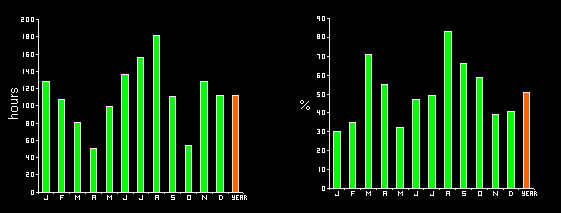
http://www.siriusobservatories.com/page5.html
|
UNIVERSIDADE DA MADEIRA |
|
GRUPO DE ASTRONOMIA |
|
The Potencial of the Island of
Madeira for Pedro Augusto |
|
ABSTRACT Ever since the
British study conducted in 1974-5, the island of Madeira has been
forgotten for optical astronomy. And yet, Encumeada Alta (at Madeira) had
the best seeing of all sites inspected by then (which included La Palma
and Mauna Kea). The downside of this 1800m site is the frequent immmersion
in the cloud inversion layer in Winter, translated into two-thirds of the
nigths in the year being lost (cf. half for La Palma and Mauna Kea). |
|
MADEIRA Not far off the african coast (Morocco), the island of Madeira enjoys a mild subtropical climate at the sea level. In the highest peaks (over 1800m) mild storms and some snow are common in the winter. These peaks are distributed in a W-E direction, dividing the island in two. The prevailing winds are from the north, which makes the north of the island very wet and the south very dry. Funchal (250 000 inhabitants) is located in the south. |
|
THE OBSERVATORY AND TELESCOPE 1) OBSERVATORY 2) TELESCOPE and INSTRUMENTATION The telescope is a MEADE 12'' (30 cm) Schmidt-Cassegrain. We have a pier and a giant field tripod as alternative supports. Using a field de-rotator, we preserve the solid altazimuthal mount. The instrumentation consists of a CCD Pictor 416XT (DT= -40º; 0.3''/9µm-pixel) + Autoguider Pictor 201XT; there is a set of standard UBVRI filters (Schüler) which give an efficiency of 25% at 550-850nm (combined with the CCD); finally, we have a Sivo vII spectrograph. |

http://www.siriusobservatories.com/page5.html
|
ENCUMEADA ALTA This is a high site (1770m) close to the highest peaks of the island, in the north (see below). It consists of a small plateau at 16º56'W and 32º46'N. The mountain is steep all the way down to the sea (8 km away in a straigth line), facing the prevailing north winds. The site thus avoids the lee-side turbulence in its southern slope. The site is well away from the light polution of Funchal.
|

|
THE CASE FOR ENCUMEADA ALTA McInnes (1981)
conducted a campaign between Jan 1974 and Apr 1975 to study the quality of
this sitefor astronomical optical observations. At the figure below, we
reproduce their results, including the year means : at the right
we show the
number of photometric hours per month: at the left
the percentage of
time with a seeing better than 1''. |

|
REFERENCES |
|
ACKNOWLEDGEMENTS |